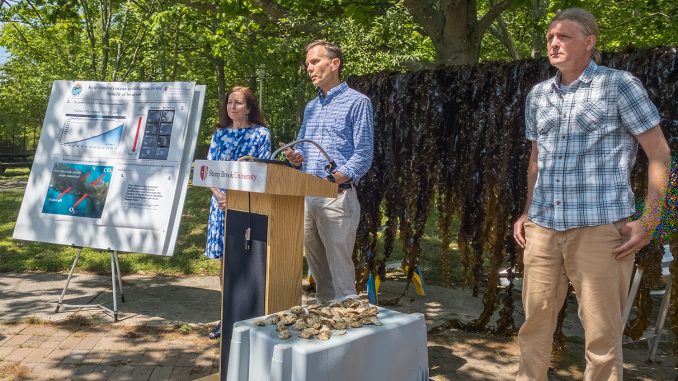
Researchers at Stony Brook University have discovered a way to combat ocean acidification with a culture of shellfish and kelp, potentially benefiting local marine ecosystems, shellfish farmers and economies as soon as this year.
Christopher Gobler, endowed chair of Coastal Ecology and Conservation and professor at Stony Brook School of Marine and Atmospheric Sciences, and Michael Doall, associate director for bivalve restoration, presented their field work to a small group Wednesday on the university campus.
The research, published last month in Frontiers in Marine Science journal, was conducted at the Great Gun Shellfish oyster farm in Moriches Bay and showed significant changes in oyster growth where kelp was also cultivated. These findings could be significant for the preservation of the shellfish industry on Long Island, as well as aid in fighting the effects of climate change.
Why is ocean acidification important?
Ocean acidification is a process of climate change that results in low pH levels and high carbon dioxide levels in the ocean, killing bivalves or preventing their growth. According to Mr. Gobler, the concentration of carbon dioxide in the atmosphere is continuing to increase at an accelerating rate. As portions of this carbon dioxide are absorbed into the ocean, pH levels in the water decrease.
“The impacts of ocean acidification are less visible and more subtle, but just as meaningful,” said Adrienne Esposito, executive director of Citizens Campaign for the Environment. For organisms like bivalves that have shells made of calcium carbonate, the increase of carbon makes forming the hard part of their shells more difficult, killing organisms or stunting their growth.
“A lot of times when people think about climate change, they’re going to say to themselves, ‘Oh that’s far off in the future, I can put that off,’” Mr. Gobler said. “When it comes to ocean acidification, we actually experience that in our coastal waters here on Long Island.”
How can kelp help?
The answer is as simple as fifth grade science: photosynthesis. “Photosynthesis involves the assimilation or taking up of carbon dioxide out of the water,” Mr. Gobler said. “What we’re doing to our atmosphere into our oceans, the seaweeds are doing in reverse. They’re actually pulling that carbon dioxide out of it.”

Mr. Doall realized this potential of kelp about 10 years ago when he owned an oyster farm in Montauk. As he was looking for ways to diversify his business, he met someone in Maine who was growing kelp. He had never heard of growing kelp and wasn’t sure what purpose it could serve, but the more he researched it, he realized that it was the “perfect companion.”
Kelp is a cold-water species with a growing season opposite of oysters. While oyster farms are labor intensive in the summer months while they are being harvested, work could also be done in the winter months to grow kelp, giving farms more growing seasons and turning seasonal employment to full-time.
What does the research show?
In 2018, Mr. Doall and Mr. Gobler partnered with a few oyster farms across Long Island to conduct field experiments for their kelp theories. Since then, the researchers have expanded to 16 locations ranging from the East River in Manhattan east to Fisher’s Island.
The research sample cited in the study found that after only one or two days, kelp can increase the pH of seawater to so-called basification conditions, which is what the shellfish require for maximum growth. Mr. Gobler reported that the oysters grown with the kelp were five times greater than the oysters grown further away. Mr. Doall also discovered a way to cultivate kelp in shallow waters and has found that the shallow water estuaries on the South Shore produced the best growth results.

What does this mean for local communities?
Because of Mr. Doall and Mr. Gobler’s research, farmers may be able to start commercially growing kelp in time for the growing season this year.
“Farmers are really on the frontlines of the battle to protect coastal environment with the work they do every day,” Mr. Doall said. “Being able to add kelp to their farms just gives them one more tool, one more weapon in the arsenal, to really win this fight against nutrient pollution.”
He said that many of the farmers the research team worked with already submitted their permit applications to New York State to grow kelp and worked out the techniques. All they need is state approval.
If approved, kelp could be sold to restaurants or used in cosmetic and skin care products, generating more revenue for farmers all while allowing them to produce better shellfish yields. On top of that, the marine climate change issues would also be combated.
“By improving our local waterways — such that the kelp project will do — we can improve our environment, improve our economy, preserve our maritime culture and help fight climate change,” Ms. Esposito said. “That’s a pretty significant study, and that’s a pretty significant result.”

